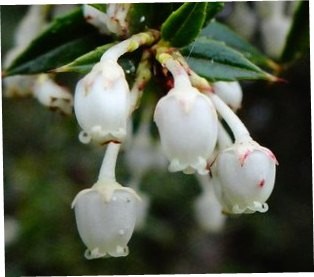Prickly heath
(Gaultheria racemulosa)

Description
Gaultheria is a genus of about 135 species of shrubs in the family Ericaceae. The name commemorates Jean François Gaultier of Quebec, an honour bestowed by the Scandinavian Pehr Kalm in 1748 and taken up by Carl Linnaeus in his Species Plantarum. These plants are native to Asia, Australasia and North and South America. In the past, the Southern Hemisphere species were often treated as the separate genus Pernettya, but no consistent reliable morphological or genetic differences support recognition of two genera, and they are now united in the single genus Gaultheria. The species vary from low, ground-hugging shrubs less than 10 cm (3.9 in) tall, up to 2.5 m (8 ft 2 in) tall, or, in the case of G. fragrantissima from the Himalayas, even a small tree up to 5–6 m (16–20 ft) tall. The leaves are evergreen, alternate (opposite in G. oppositifolia from New Zealand), simple, and vary between species from 3 to 10 cm (1.2 to 3.9 in) long; the margins are finely serrated or bristly in most species, but entire in some. The flowers are solitary or in racemes, bell-shaped, with a five-lobed (rarely four-lobed) corolla; flower colour ranges from white to pink to red. The fruit is a fleshy berry in many species, a dry capsule in some, with numerous small seeds. Several species are grown as ornamental shrubs in gardens, particularly G. mucronata (Pernettya mucronata) from southern Chile and Argentina and G. shallon (salal) from the Pacific Northwest of North America. Many of the smaller species are suitable for rock gardens. Like most other ericaceous plants, Gaultheria species do best in peaty soil that never fully dries out. The fruit of many Gaultheria species is edible, particularly that of salal, which can be used to make jelly. One, the American wintergreen or eastern teaberry, G. procumbens, is the traditional source of wintergreen flavouring; it is called the eastern teaberry because its leaves can be used to make a tea, and its berries can be eaten as are. The fruit of most other Gaultheria species is insipid in flavour and not extensively consumed. One variety of G. leucocarpa shows anti-inflammatory properties and is used in Chinese herbal medicine for the treatment of rheumatoid arthritis, swelling, and pain.
Taxonomic tree:







